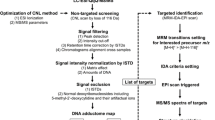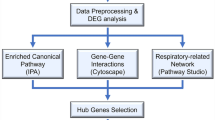Abstract
As a widespread industrial chemical, formaldehyde carcinogenicity has been highly controversial. Meanwhile, formaldehyde is an essential metabolite in all living cells. Previously, we have demonstrated exogenous formaldehyde causes DNA adducts in a nonlinear manner between 0.7 and 15.2 ppm using [13CD2]-formaldehyde for exposure coupled with the use of sensitive mass spectrometry. However, the responses from exposure to low doses of formaldehyde are still unknown. In this study, rats were exposed to 1, 30, and 300 ppb [13CD2]-formaldehyde for 28 days (6 h/day) by nose-only inhalation, followed by measuring DNA mono-adduct (N2-HOMe-dG) and DNA–protein crosslinks (dG-Me-Cys) as formaldehyde specific biomarkers. Both exogenous and endogenous DNA mono-adducts and dG-Me-Cys were examined with ultrasensitive nano-liquid chromatography–tandem mass spectrometry. Our data clearly show that endogenous adducts are present in all tissues analyzed, but exogenous adducts were not detectable in any tissue samples, including the most susceptible nasal epithelium. Moreover, formaldehyde exposure at 1, 30 and 300 ppb did not alter the levels of endogenous formaldehyde-induced DNA adducts or DNA–protein crosslinks. The novel findings from this study provide new data for risk assessment of exposure to low doses of formaldehyde.





Similar content being viewed by others
Abbreviations
- FA:
-
Formaldehyde
- dG:
-
Deoxyguanosine
- DPCs:
-
DNA–protein crosslinks
- HCD:
-
Higher-energy collisional dissociation
- MS/MS:
-
Tandem mass spectrometry
- PRM:
-
Parallel reaction monitoring
- SRM:
-
Selected reaction monitoring
References
Aydin S, Canpinar H, Undeger U, Guc D, Colakoglu M, Kars A et al (2013) Assessment of immunotoxicity and genotoxicity in workers exposed to low concentrations of formaldehyde. Arch Toxicol 87:145–153
Casanova M, Heck HD, Everitt JI, Harrington WW, Popp JA (1988) Formaldehyde concentrations in the blood of rhesus monkeys after inhalation exposure. Food Chem Toxicol 26:715–716
Dhareshwar SS, Stella VJ (2008) Your prodrug releases formaldehyde: should you be concerned? No! J Pharm Sci 97:4184–4193
Edrissi B, Taghizadeh K, Moeller BC, Kracko D, Doyle-Eisele M, Swenberg JA et al (2013) Dosimetry of N6-formyllysine adducts following 13CD2-formaldehyde exposures in rats. Chem Res Toxicol 26:1421–1423
Edrissi B, Taghizadeh K, Moeller BC, Yu R, Kracko D, Doyle-Eisele M et al (2017) N6-formyllysine as a biomarker of formaldehyde exposure: formation and loss of N6-formyllysine in nasal epithelium in long-term, low-dose inhalation studies in rats. Chem Res Toxicol 30:1572–1576
Garaycoechea JI, Patel KJ (2014) Why does the bone marrow fail in Fanconi anemia? Blood 123:26–34
Garaycoechea JI, Crossan GP, Langevin F, Daly M, Arends MJ, Patel KJ (2012) Genotoxic consequences of endogenous aldehydes on mouse haematopoietic stem cell function. Nature 489:571–575
Ide H, Shoulkamy MI, Nakano T, Miyamoto-Matsubara M, Salem AM (2011) Repair and biochemical effects of DNA–protein crosslinks. Mutat Res 711:113–122
International Agency for Research on Cancer (2006) Formaldehyde, 2-butoxyethanol and 1-tert-butoxypropan-2-ol. IARC Monogr Eval Carcinog Risks Hum 88:1–478
Lai Y, Yu R, Hartwell HJ, Moeller BC, Bodnar WM, Swenberg JA (2016) Measurement of endogenous versus exogenous formaldehyde-induced DNA–protein crosslinks in animal tissues by stable isotope labeling and ultrasensitive mass spectrometry. Cancer Res 76:2652–2661
Langevin F, Crossan GP, Rosado IV, Arends MJ, Patel KJ (2011) Fancd2 counteracts the toxic effects of naturally produced aldehydes in mice. Nature 475:53–58
Liu J, Liu FY, Tong ZQ, Li ZH, Chen W, Luo WH et al (2013) Lysine-specific demethylase 1 in breast cancer cells contributes to the production of endogenous formaldehyde in the metastatic bone cancer pain model of rats. PLoS One 8:e58957
Liu CW, Tian X, Hartwell HJ, Leng J, Chi L, Lu K et al (2018) Accurate measurement of formaldehyde-induced DNA–protein cross-links by high-resolution orbitrap mass spectrometry. Chem Res Toxicol 31:350–357
Lu K, Ye W, Gold A, Ball LM, Swenberg JA (2009) Formation of S-[1-(N2-deoxyguanosinyl)methyl]glutathione between glutathione and DNA induced by formaldehyde. J Am Chem Soc 131:3414–3415
Lu K, Collins LB, Ru H, Bermudez E, Swenberg JA (2010a) Distribution of DNA adducts caused by inhaled formaldehyde is consistent with induction of nasal carcinoma but not leukemia. Toxicol Sci 116:441–451
Lu K, Ye W, Zhou L, Collins LB, Chen X, Gold A et al (2010b) Structural characterization of formaldehyde-induced cross-links between amino acids and deoxynucleosides and their oligomers. J Am Chem Soc 132:3388–3399
Lu K, Moeller B, Doyle-Eisele M, McDonald J, Swenberg JA (2011) Molecular dosimetry of N2-hydroxymethyl-dG DNA adducts in rats exposed to formaldehyde. Chem Res Toxicol 24:159–161
Lu K, Craft S, Nakamura J, Moeller BC, Swenberg JA (2012) Use of LC–MS/MS and stable isotopes to differentiate hydroxymethyl and methyl DNA adducts from formaldehyde and nitrosodimethylamine. Chem Res Toxicol 25:664–675
Magana-Schwencke N, Ekert B (1978) Biochemical analysis of damage induced in yeast by formaldehyde. II. Induction of cross-links between DNA and protein. Mutat Res 51:11–19
McGhee JD, von Hippel PH (1977) Formaldehyde as a probe of DNA structure. r. Mechanism of the initial reaction of formaldehyde with DNA. Biochemistry 16:3276–3293
Moeller BC, Lu K, Doyle-Eisele M, McDonald J, Gigliotti A, Swenberg JA (2011) Determination of N2-hydroxymethyl-dG adducts in the nasal epithelium and bone marrow of nonhuman primates following 13CD2-formaldehyde inhalation exposure. Chem Res Toxicol 24:162–164
Nielsen GD, Larsen ST, Wolkoff P (2013) Recent trend in risk assessment of formaldehyde exposures from indoor air. Arch Toxicol 87:73–98
Nielsen GD, Larsen ST, Wolkoff P (2017) Re-evaluation of the WHO (2010) formaldehyde indoor air quality guideline for cancer risk assessment. Arch Toxicol 91:35–61
Pontel LB, Rosado IV, Burgos-Barragan G, Garaycoechea JI, Yu R, Arends MJ et al (2015) Endogenous formaldehyde is a hematopoietic stem cell genotoxin and metabolic carcinogen. Mol Cell 60:177–188
Ren X, Ji Z, McHale CM, Yuh J, Bersonda J, Tang M et al (2013) The impact of FANCD2 deficiency on formaldehyde-induced toxicity in human lymphoblastoid cell lines. Arch Toxicol 87:189–196
Shi Y, Lan F, Matson C, Mulligan P, Whetstine JR, Cole PA et al (2004) Histone demethylation mediated by the nuclear amine oxidase homolog LSD1. Cell 119:941–953
Stingele J, Bellelli R, Boulton SJ (2017) Mechanisms of DNA–protein crosslink repair. Nat Rev Mol Cell Biol 18:563–573
Swenberg JA, Kerns WD, Mitchell RI, Gralla EJ, Pavkov KL (1980) Induction of squamous cell carcinomas of the rat nasal cavity by inhalation exposure to formaldehyde vapor. Cancer Res 40:3398–3402
Swenberg JA, Lu K, Moeller BC, Gao L, Upton BP, Nakamura J et al (2011) Endogenous versus exogenous DNA adducts: their role in carcinogenesis, epidemiology, and risk assessment. Toxicol Sci 120(Suppl 1):S130–S145
Swenberg JA, Moeller BC, Lu K, Rager JE, Fry RC, Starr TB (2013) Formaldehyde carcinogenicity research: 30 years and counting for mode of action, epidemiology, and cancer risk assessment. Toxicol Pathol 41:181–189
Yu R, Lai Y, Hartwell HJ, Moeller BC, Doyle-Eisele M, Kracko D et al (2015) Formation, accumulation, and hydrolysis of endogenous and exogenous formaldehyde-induced DNA damage. Toxicol Sci 146:170–182
Zhang L, Tang X, Rothman N, Vermeulen R, Ji Z, Shen M et al (2010) Occupational exposure to formaldehyde, hematotoxicity, and leukemia-specific chromosome changes in cultured myeloid progenitor cells. Cancer Epidemiol Biomark Prev 19:80–88
Acknowledgements
We thank Dr. Leonard Collins for his assistance with HPLC purification and nano-UPLC–MS–MS. This project received funding from the American Chemistry Council and Formacare. The instrumentation was partially supported by funding from the NIEHS (R01ES024950 and P30ES010126). None of the funding agencies is involved in writing or have access to the manuscript before its submission.
Author information
Authors and Affiliations
Corresponding authors
Ethics declarations
Conflict of interest
The authors declare they have no actual or potential competing financial interests.
Additional information
Publisher’s Note
Springer Nature remains neutral with regard to jurisdictional claims in published maps and institutional affiliations.
Rights and permissions
About this article
Cite this article
Leng, J., Liu, CW., Hartwell, H.J. et al. Evaluation of inhaled low-dose formaldehyde-induced DNA adducts and DNA–protein cross-links by liquid chromatography–tandem mass spectrometry. Arch Toxicol 93, 763–773 (2019). https://doi.org/10.1007/s00204-019-02393-x
Received:
Accepted:
Published:
Issue Date:
DOI: https://doi.org/10.1007/s00204-019-02393-x




